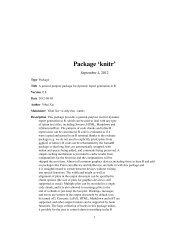78 openColoursnNote that because of the way these schemes have been developed they only existover certain number of colour gradations (typically 3–10) — see ?brewer.palfor actual details. If less than or more than the required number of colours issupplied then openair will interpolate the colours.number of colours required.DetailsThis in primarily an internal openair function to make it easy for users to select particular colourschemes, or define their own range of colours of a user-defined length.Each of the pre-defined schemes have merits and their use will depend on a particular situation. Forshowing incrementing concentrations e.g. high concentrations emphasised, then "default", "heat","jet" and "increment" are very useful. See also the description of RColorBrewer schemes for theoption scheme.To colour-code categorical-type problems e.g. colours for different pollutants, "hue" and "brewer1"are useful.When publishing in black and white, "greyscale" is often convenient. With most openair functions,as well as generating a greyscale colour gradient, it also resets strip background and other colouredtext and lines to greyscale values.Failing that, the user can define their own schemes based on R colour names. To see the full list ofnames, type colors() into R.ValueReturns colour values - see examples below.Author(s)David CarslawReferenceshttp://colorbrewer.orgExamples# to return 5 colours from the "jet" scheme:cols
percentileRose 79percentileRoseFunction to plot percentiles by wind directionDescriptionUsagepercentileRose plots percentiles by wind direction with flexible conditioning. The plot can displaymutiple percentile lines or filled areas.ArgumentspercentileRose(mydata, pollutant = "nox",type = "default", percentile = c(25, 50, 75, 90, 95),cols = "default", fill = TRUE, intervals = NULL,angle.scale = 45, auto.text = TRUE, key.header = NULL,key.footer = "percentile", key.position = "bottom",key = TRUE, ...)mydatapollutanttypeA data frame minimally containing wd and a numeric field to plot — pollutant.Mandatory. A pollutant name corresponding to a variable in a data frame shouldbe supplied e.g. pollutant = "nox". More than one pollutant can be suppliede.g. pollutant = c("no2", "o3") provided there is only one type.type determines how the data are split i.e. conditioned, and then plotted. Thedefault is will produce a single plot using the entire data. Type can be one ofthe built-in types as detailed in cutData e.g. “season”, “year”, “weekday” andso on. For example, type = "season" will produce four plots — one for eachseason.It is also possible to choose type as another variable in the data frame. If thatvariable is numeric, then the data will be split into four quantiles (if possible)and labelled accordingly. If type is an existing character or factor variable, thenthose categories/levels will be used directly. This offers great flexibility for understandingthe variation of different variables and how they depend on oneanother.Type can be up length two e.g. type = c("season", "weekday") will producea 2x2 plot split by season and day of the week. Note, when two types areprovided the first forms the columns and the second the rows.percentile The percentile value(s) to plot. Must be between 0–100.colsColours to be used for plotting. Options include “default”, “increment”, “heat”,“jet” and RColorBrewer colours — see the openair openColours functionfor more details. For user defined the user can supply a list of colour namesrecognised by R (type colours() to see the full list). An example would becols = c("yellow", "green", "blue")fill Should the percentile intervals be filled (default) or should lines be drawn (fill =FALSE).
















